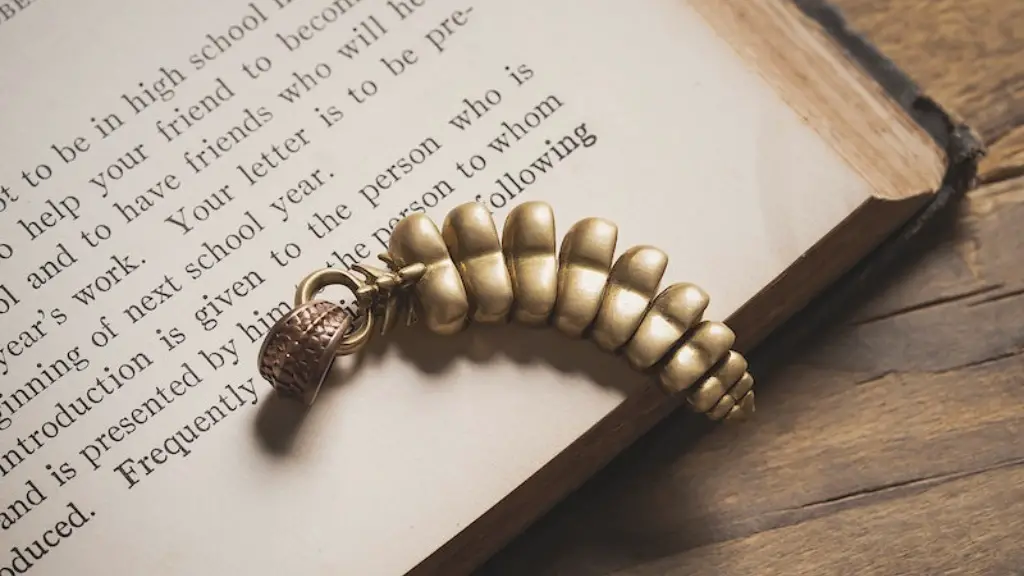Step One: Recognize Three Main Forms of Foot
When it comes to identifying feet in poetry, there are three main forms of foot to recognize: the iamb, the trochee, and the anapest. An iamb consists of two syllables, with the first one being unstressed, and the second one being stressed — for example, “a-long”. The trochee is the opposite of the iamb, with the first syllable being stressed and the second syllable being unstressed, as in the words, “heart-felt”. The anapest, or “double iamb,” is composed of three syllables, with the first two syllables being unstressed and the last syllable being stressed. An example of an anapest is “un-der-stand.”
Step Two: Find Rhyme Schemes and Metric Patterns
In poetry, it is also important to look for rhyme schemes and metric patterns to identify feet. Rhyme schemes are patterns of end-rhymes throughout the poem, written in different letters to signify which lines rhyme. For example, an ababcdcdefefghgh rhyme scheme would mean that the first and third lines rhyme with each other, the fourth and sixth lines rhyme with each other, the seventh and ninth lines rhyme with each other, and the tenth and twelfth lines rhyme with each other. Metric patterns are patterns of stressed and unstressed syllables throughout the poem. For example, a poem written in iambic pentameter would have five iambs per line, or five sets of unstressed and stressed syllables.
Step Three: Learn to Recognize Metrical Variations
Once you have identified a particular foot and metric pattern in a poem, it is important to pay attention to metrical variations. These are words that break from the meter’s pattern, such as using a trochee instead of an iamb. Such variations often indicate the poem’s main focus or emotion, so examine the lines that contain them closely. Also, consider the context of the line to identify the poet’s intended meaning.
Step Four: Revisit the Poem
Once you have examined the poem to determine its rhyme scheme, meter, and metrical variations, it is time to revisit the poem to draw conclusions. How does the meter contribute to the theme of the poem? Does the meter reflect a particular emotion? In what ways do the metrical variations contribute to the poem’s overall meaning? When revisiting the poem, look for patterns, both in the repetition of words and in the placement of metrical variations. By considering the patterns of the poem, you will be better able to understand the poet’s intent.
Step Five: Check the Historical Background
In some cases, it can be beneficial to examine the historical background of a poem. For example, many older poems were written in classical meters, such as dactylic hexameter. Classically trained poets often paid meticulous attention to the meter and rhyme in their work, and knowing the traditions behind them can help in identifying feet in the poem.
Step Six: Consider the Context
When attempting to identify feet in poetry, it is important to keep the context of the poem in mind. Consider the themes, imagery, and metaphors used in the poem, and think about how the meter and rhyme can contribute to the overall message of the poem. Some meters are better suited to certain types of poetry than others — for example, an iambic meter is often considered to be more conversational than a trochaic meter, while an anapestic meter is commonly used to evoke a sense of joy or lightness. Thus, context can help to narrow down the type of meter used in a poem.
Step Seven: Analyze Metrical Variations and Patterns
Once you have identified a meter and rhyme scheme in a poem, take the time to analyze the metrical variations and patterns. Metrical variations can often indicate a change in subject or a shift in emotion. Patterns of repeated words, rhythms, and images can contribute to the overall theme of the poem. By looking for patterns, you can better appreciate the poet’s overall message and gain new insights into the poem.
Forms of Elision and Feminine Endings
When identifying feet in poetry, it is also important to consider forms of elision and feminine endings, which are words that contain an added unstressed syllable to close a line. For example, the word “flower” may be written as “flow-er” or “flow’er,” with the addition of an unstressed syllable. Thus, when scanning a line for feet, it is important to consider that words with two syllables may actually contain three syllables, as well as words with one syllable potentially containing two syllables.
Secondary Stress and Special Meters
In some cases, a meter can contain an additional stressed syllable known as a secondary stress. For example, a poem with an iambic tetrameter could contain one extra stressed syllable, making it an iambic trimeter. Additionally, some special meters, such as the choriamb, do not follow the basic rules of iambic, trochaic, or anapestic feet. The choriamb is composed of alternately stressed and unstressed syllables, such as “a-li-en-ate.” To recognize these uncommon meters, it is important to pay close attention to the arrangement and the stresses of the syllables.
Metrical Intonation and Structural Aspects
When it comes to identifying feet in poetry, it is also important to consider metrical intonation and structural aspects. Metrical intonation refers to the placement and variation of stress within each line. This can be used to emphasize certain words or to create a particular mood. Similarly, structural aspects refer to the form and organization of the poem, such as its stanzas, rhyme scheme, and overall meter. Examining these elements can provide insight into the poet’s overall meaning.


